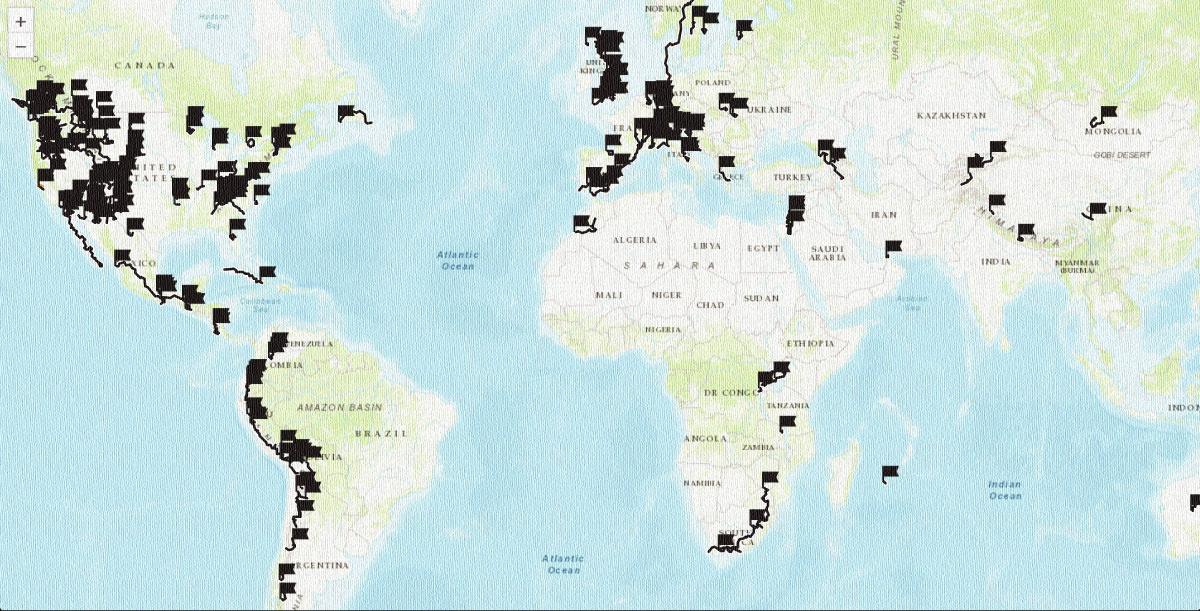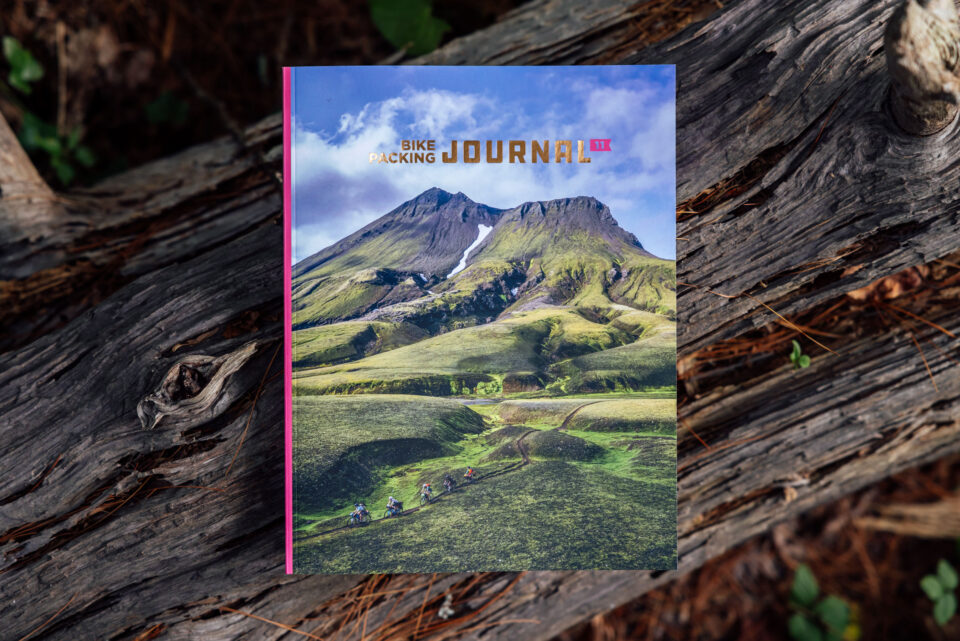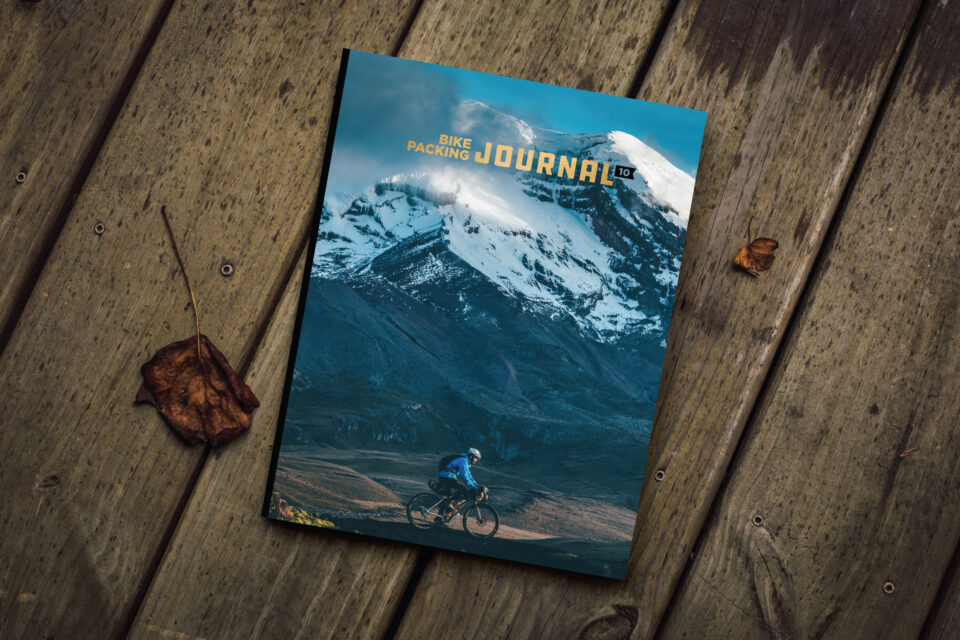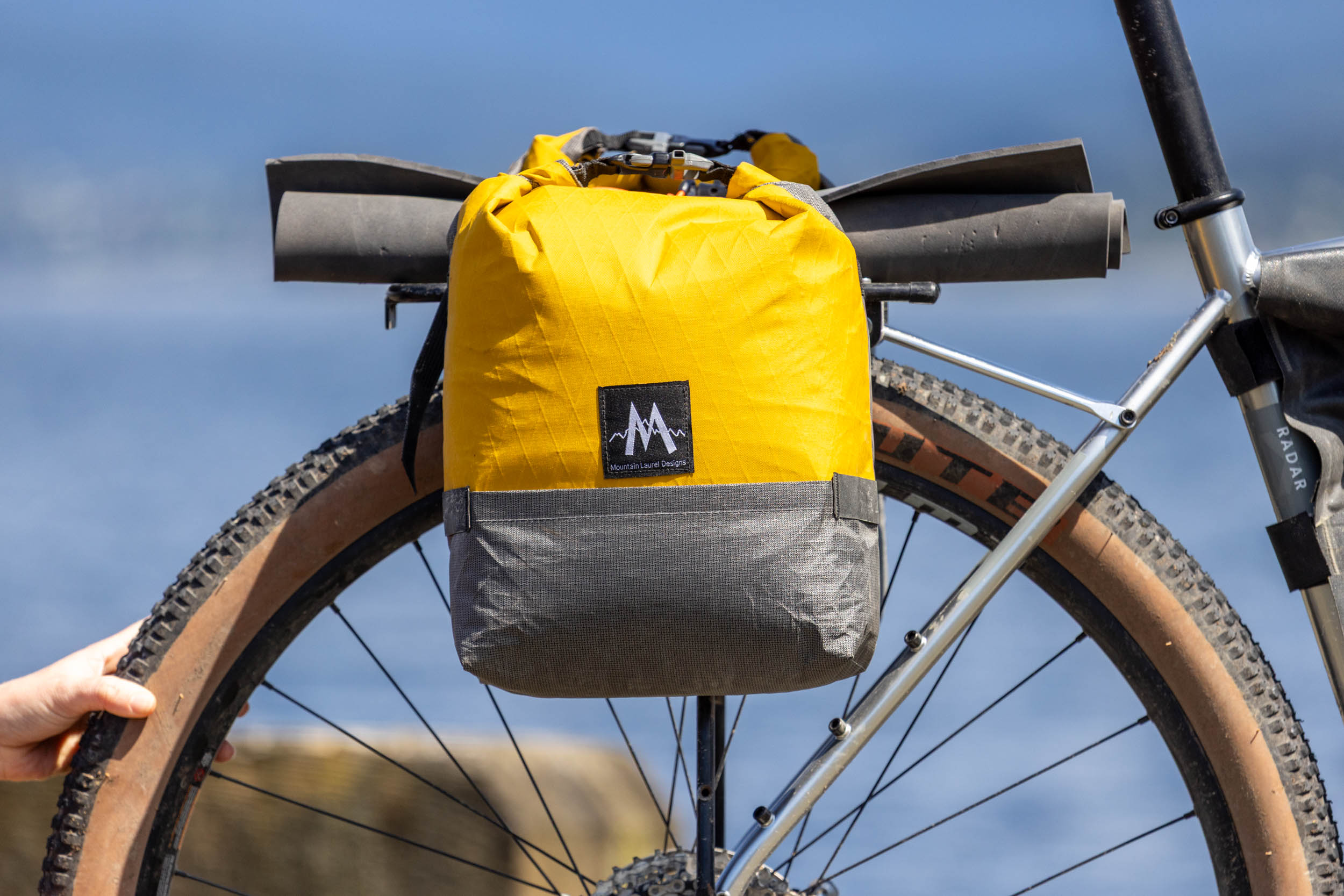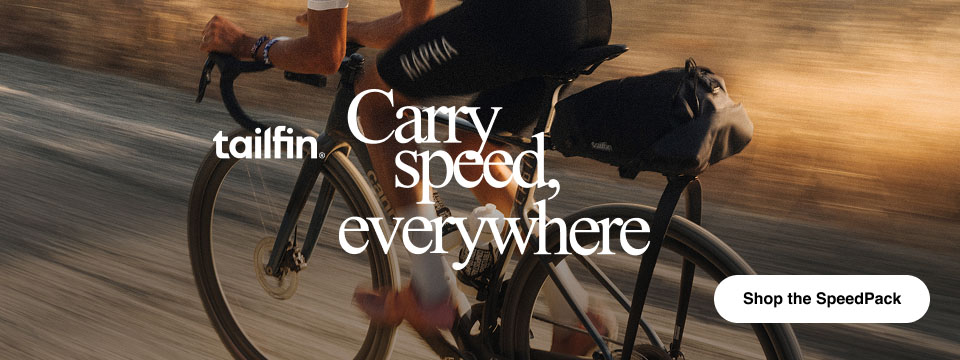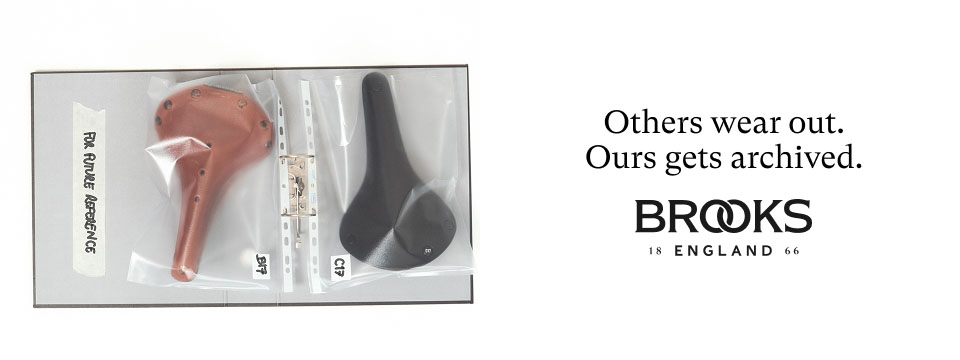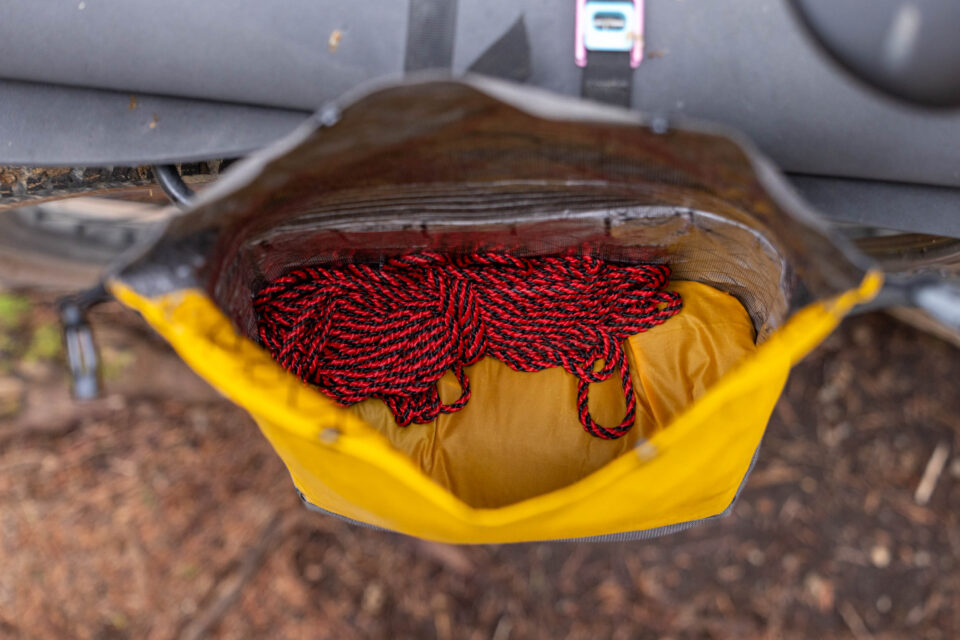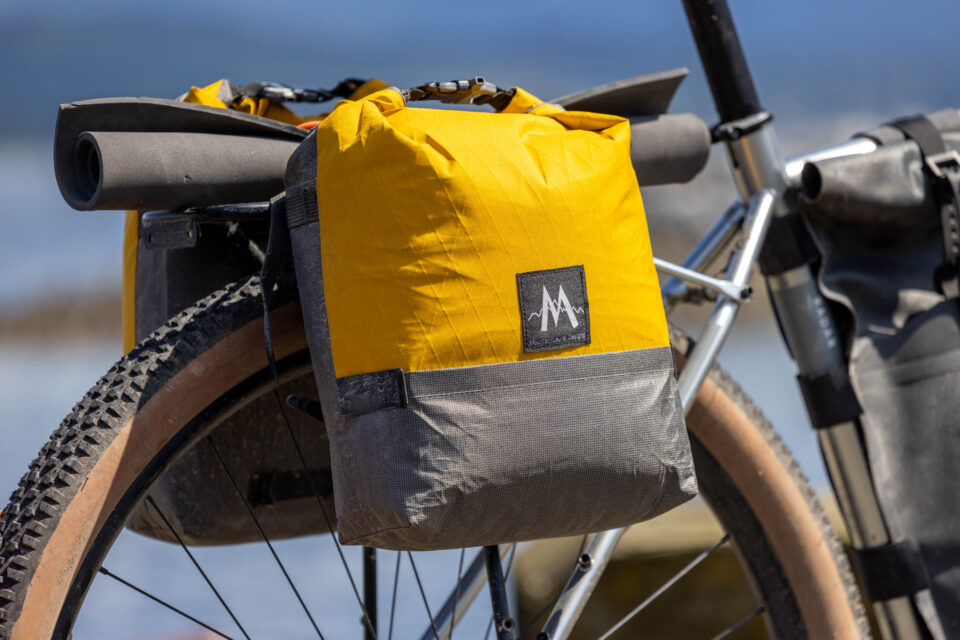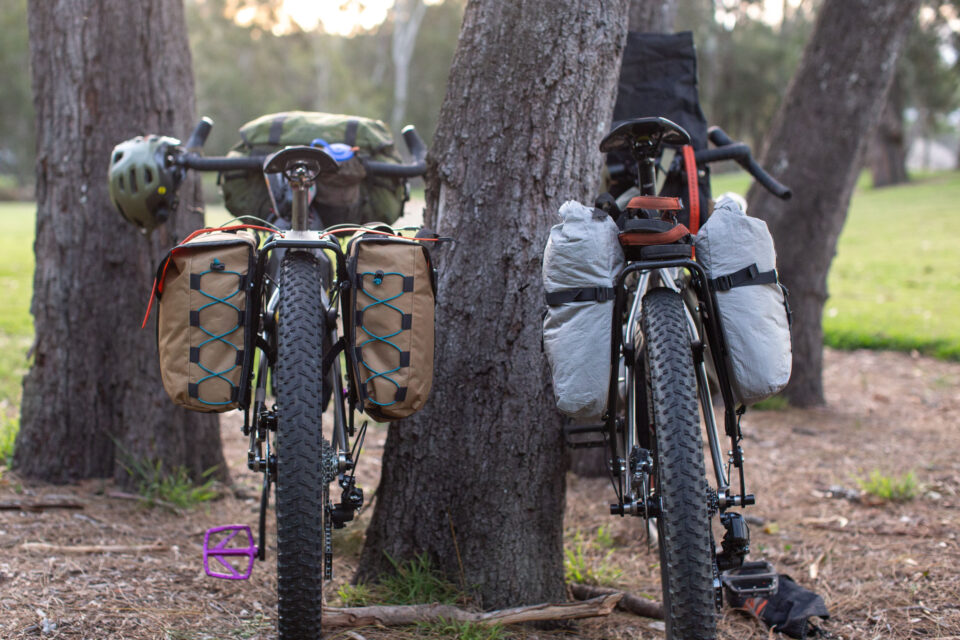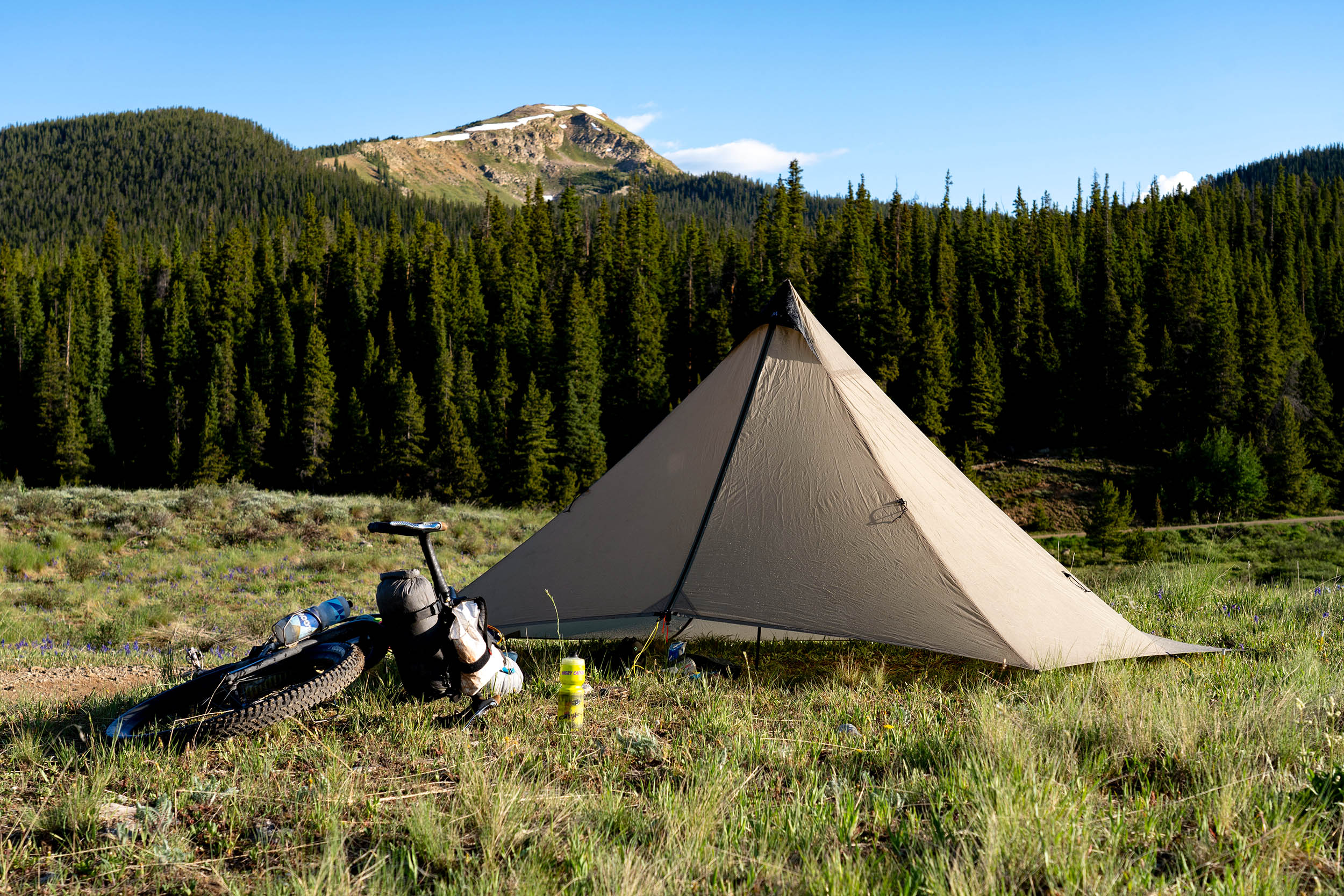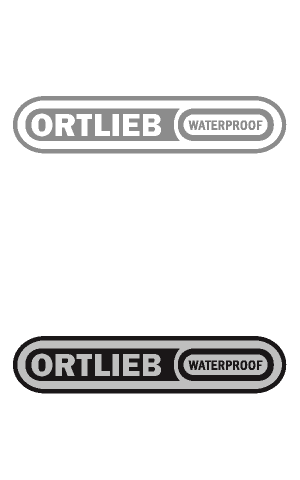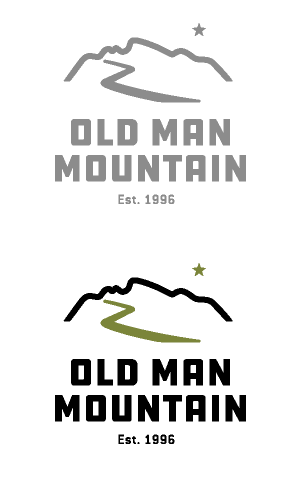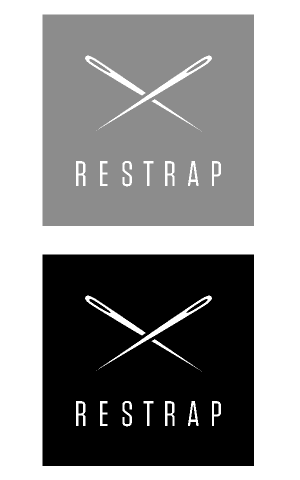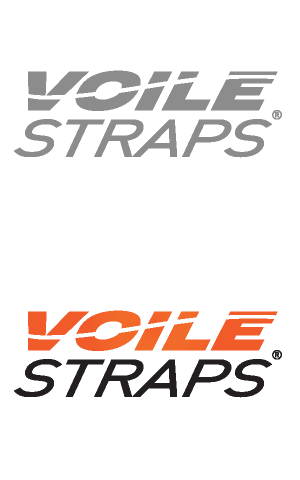Mountain Laurel Designs Poco Panniers Review (V3): The Lightest Waterproof Pannier
The updated Mountain Laurel Designs Poco Panniers (V3) prioritize simplicity and durability above all, featuring a roll-top closure, no excess stitching, two built-in carbon stiffeners, and a waterproof construction. Miles has been testing the smallest version over the last five months. Find his Mountain Laurel Designs Poco Panniers review here…
PUBLISHED Jul 22, 2025
Last year, Revelate Designs posted an April Fools’ post for a made-up product called the Whatever Bag. It poked fun at bikepackers with four handlebar attachment straps, five rubber straps for lashing items to, daisy chains, and more. At the time, what stood out to me was Revelate’s founder Eric Parsons’ tongue-in-cheek comment about the bag being made from “fancy white fabric,” because white fabric is really high-tech… right?
This recently got me thinking about the varied approaches bag makers take to create new products. Some are eager to use the latest and greatest fabrics and construction techniques, sometimes even partnering with fabric manufacturers to help test pre-production materials that appear to have been warped back to us from the future. An equal number of makers have continued to rely on tried-and-true materials, such as waxed canvas, Cordura, and some of the original X-Pac, which has been around since the early 1990s.

Whether they’re using them or not, the number of super-technical fabrics available to gear makers has skyrocketed in the last few years. We’re seeing more options made from recycled materials, better tear and abrasion resistance, and continued innovations to cut weight. Many of these advancements originate in the backpacking world and then trickle over into bikepacking gear as manufacturers discover them—but some brands are quicker to the punch.
Mountain Laurel Designs (MLD) was started by Ron Bell in 2002. His first products were lightweight tarps, but he quickly expanded the product line to include ponchos and backpacks. The focus has always been to produce the lightest functional gear, and in the years to follow, Ron became obsessed with testing and comparing technical lightweight fabrics. Everything Mountain Laurel Designs offers is handmade in Roanoke, Virginia.

In a recent conversation with Ron, I learned that MLD has played a more hands-on role in developing new fabrics than I realized. It turns out they worked closely with Challenge Outdoor to help develop their UltraX fabric and were among the first few brands in the backpacking world to adopt it. MLD has also been using X-Pac—made by Dimension Polyant—for over 25 years. Interestingly, the same fabric engineer, the late Hale Walcoff, who developed the original X-Pac fabric at Dimension Polyant two decades ago, later moved to Challenge Outdoor, where he created the UltraX line. His mission remained consistent: to design the highest-quality, most eco-friendly technical fabrics for this kind of gear.
MLD Goes Bikepacking
Ron’s obsession with using the lightest, most technically advanced fabrics hasn’t subsided over the years. This has also carried over to Mountain Laurel Designs’ bikepacking lineup, which debuted in 2022 with the release of lightweight panniers and a single-ended dry bag. Since then, the bikepacking category has expanded to include more dry bag options, a handlebar harness, and more.
MLD’s roll-top panniers have undergone a few updates since their launch, but they have maintained a lightweight construction, simple design, and foolproof roll-top closure. The original version had no extra stiffeners or features beyond a unique attachment system and was made of Challenge Outdoor’s EcoPak ULTRA, which was eventually replaced by the new UltraX fabric. Earlier this year, the third iteration of the Poco Panniers was announced, which looks nearly identical to the earlier versions, save a few clever details and improvements.
Our own Cass Gilbet tested the original version (pictured above), which had some durability issues that were addressed in the V2 model, and it has been performing well since. He has managed to wear some pinprick holes in his, but the V3 version should improve on that, according to MLD.

The Poco Panniers V3 maintain the same attachment system as the original. While it’s noy a revolutionary idea to use webbing straps and velcro, Ron used this design to eliminate the extra weight and potential failure points of a clip-on/off pannier system. MLD includes a strip of velcro that can be cut to small lengths and used as the first attachment point for the panniers, securing them to the rack. For added stability, two webbing straps (one strap and one ladder-loc buckle on each pannier) loop over the rack rails and attach to the opposite pannier. The Poco Panniers work best as a pair, but they can also be used as a single pannier by looping the webbing through the opposite rack rail and back to itself. When installed using the two upper straps, most of the weight is held by the straps and rack platform, not the velcro.
A short length of daisy chain webbing, located near the bottom of the pannier, serves as the lower attachment point. MLD provides two 12″ bungees with mini carabiner clips to secure the bottom of the panniers to the lower rack, but it can also be held in place with the included velcro, webbing straps, or Nano Voile Straps. I opted for Nano Voile Straps wrapped through both sides of the lower daisy chain and around the rack leg, resulting in a surprisingly tight grip on the rack.
On the inside, a rear HDPE stiffener panel with a carbon wand adds stability and structure to the backside of the pannier. To help maintain the pannier’s shape and reduce bulging, a front carbon fiber wand is sewn into the pannier. On previous versions, the carbon wands were simply taped into place, but they’re now inside a reinforced rolled hem and then sealed using the new Ultra TNT tape, which wasn’t available in the V1 version.
The new Ultra X fabric used on the V3 panniers is reinforced on the inside with an X weave of Ultra-High Molecular Weight Polyethylene (UHMWPE) fibers. The inside laminate is a bit thicker, which not only allows for a solid bond with the Ultra TNT Seam Tape MLD uses but also increases seam strength, creates a totally waterproof pannier, and sticks well to any type of tape for field repairs. MLD includes a 3″ x 6″ Ultra TNT patch for easy repairs.
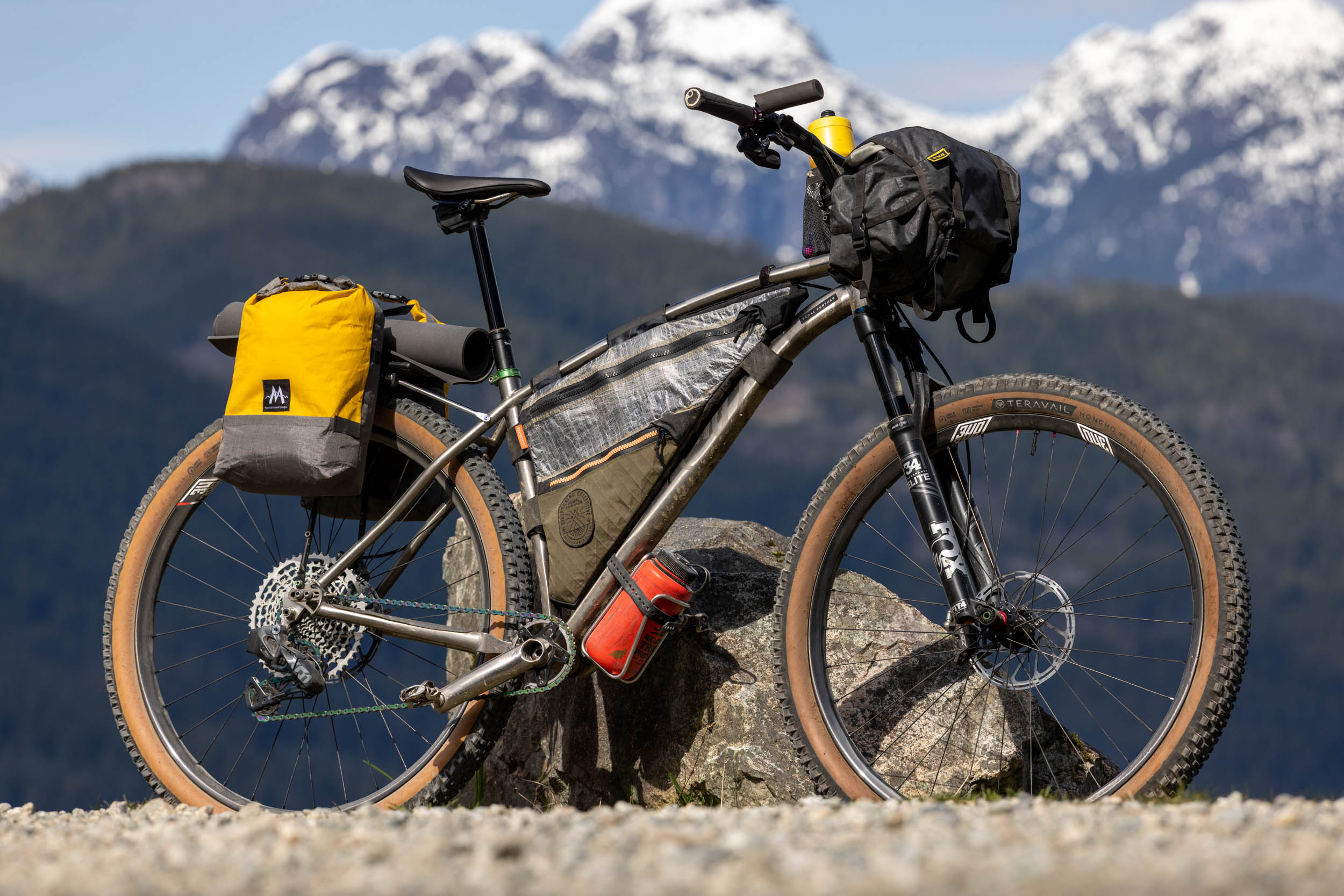
Other features include dual snaps at the top of the roll-top closure, two Hypalon mounting points on either side of the pannier for a little blinky light, and a cute little emergency whistle on the main side-release buckle. The Poco Panniers are available in three sizes: small (5-7L), medium (7-10L), and large (10-13L) in seven colors.
Every pannier is made from Dark Gray ULTRA 200X on the bottom and back, with X-Pac RX30 on the top in your choice of color. The ULTRA 200x fabric features a 33 percent recycled polyester face fabric bonded with non-toxic, carbon-neutral adhesive to a 100 percent recycled, waterproof polyester backing. RX30 is made from 100 percent post-consumer recycled polyester fabric. The face fabric doesn’t need to be quite as durable as the back and bottom, which is why RX30 is used there, and this also allows for multiple color options for customers. For those who don’t care about adding color, MLD offers a grey version made entirely of UltraX fabric, which weighs slightly less.
Lightweight Panniers Compared
| Product | Weight/pair | Size/each | Waterproof? | Price/set (USD) |
|---|---|---|---|---|
| MLD Ultra Poco Panniers V3 (medium) | 370g | 10L | Yes | $225 |
| Revelate Designs Nano Panniers | 510g | 11L | No | $250 |
| San Util Lightweight Pannier (X-Pac) | 480g | 12L | No | $280 |
| Rockgeist Microwave Panniers | 920g | 13L | Yes | $285 |
| Stealth Mountain Panniers | 680g | 8L | No | $160 |
| Tailfin Mini Panniers | 760g | 10L | Yes | $210 |
| Rambler Bags Panniers | 710g | 8.5L | No | $335 |
| Freewheel Mission Gear SL Panniers | 620g | 14L | No | $300 |
Looking at the comparison chart above, we can see that the Poco Panniers are some of the lightest available. The medium (10L) panniers weigh in at 370 grams/pair, and the small (7L) panniers I tested weigh 352 grams/pair with the included velcro, fixed straps, and a Voile Nano Strap for the lower attachment point.

I’ve also used the Revelate Designs Nano Panniers, which are perhaps the closest competitors in terms of weight and capacity. The Nano Panniers use a slightly more sophisticated attachment and compression systems, but they aren’t waterproof and weigh 140 grams more per pair. Both panniers use an attachment system that isn’t quick to remove or reinstall, unlike holster-style panniers like the Rockgeist Microwave Panniers, but when installed correctly, they hardly move at all and are perfectly suited for rough off-road riding and singletrack. The carbon fiber wand on the front of the Poco Panniers does a good job of reducing the amount of bulge and keeping the panniers low-profile, but the adjustable/floating design of the Nano Panniers is more effective. When packed tightly, both end up around the same size.
Find a breakdown of the different Poco Panniers sizes and dimensions below. Note the 3.5″ depth of the small version I tested, which helps keep the panniers tight to the rack and bike, making them better suited for hike-a-bike and tight trails.
| Size | W x D x H | Weight | Volume |
|---|---|---|---|
| Small | 8 x 3.5 x 10-12″ | 176g | 5-7L |
| Medium | 9 x 4 x 11-14″ | 185g | 7-10L |
| Large | 10 x 4.5 x 12-15″ | 215g | 10-13L |

600 Kilometers Later
Emily and I have been fighting over the Poco Panniers for nearly all of our bikepacking trips so far this year. We’ve used them in the rain on an early-season overnighter, kept them on for commuting and lake swims, and I just used them as part of my setup while scouting a new 450-kilometer bikepacking route on the southern end of Vancouver Island.
I didn’t need the extra capacity of panniers, but given their lightweight design and waterproof construction, I couldn’t convince myself not to bring them. On one side, I carried my Rab Mythic Ultra sleeping bag, an inflatable camp pillow, and some camp clothes. On the other, I packed my Big Agnes Zoom UL Insulated sleeping pad (large and wide), some food, and odds and ends for camp. I usually didn’t have to open them up during the day, but if I needed some overflow packing space, they were there waiting for me and easy to access.

Panniers will almost always work better on a rack designed with them in mind, not minimal racks like the Tumbleweed T-Rack or Mica Rat Tail, but I took the chance on my Rat Tail and was happy I did. The legs of the rack, the thin HDPE panel inside the back panel, and the two carbon wands all work together to create a surprisingly stable setup. I was worried the single leg of the Rat Tail Rack wouldn’t be enough to support the bag, and the panniers would fold in toward the rear wheel, but after 450km of rugged coastal British Columbia logging roads, I had no issues with rubbing, slippage, or pannier movement.
I left the three-pack bolts on the Rat Tail legs in place on one side and replaced the other with smooth plastic plugs. Both sides show standard wear expected from seven days of dusty gravel, but the fabric and webbing remain intact. At some point after I tested the Revelate Designs Nano Panniers, they updated them with reinforced X-Pac back panels, likely due to the amount of abrasion the back of panniers see, so we’ll see how the Poco Panniers hold up after another 600 kilometers.

My only real complaint is the attachment system, which is far more difficult to take on and off the bike than a removable drybag system. It’s so much easier to stuff your gear into bags off the bike, and then either slide it into the pannier or use a holster-style setup. I shared the same feedback when I reviewed the Revelate Designs Nano Panniers, and the following year at Sea Otter, they teased their new holster pannier, which we’re eagerly waiting to launch. Mountain Laurel Designs also sells DCF Food Bags that fit inside the panniers, which may be a good option for separating gear from food and packing it off the bike.
Mountain Laurel Designs offers several helpful tips on its website to maximize the use of the Poco Panniers. Abrasion is a real issue with lightweight panniers that mount flush to racks, so adding Gorrilla Tape in high-abrasion areas on the rack will help prevent premature wear. The same method can be used to cover threaded cargo bosses, which might damage the backside of the pannier. There’s something about taping your rack that feels somewhat DIY, and that won’t be for everyone, but what I’ve seen from Mountain Laurel Designs (including their website), this aligns with their less-is-more attitude. I find the tinkerer-friendly nature of their products quite charming and refreshing.
For an ultra-stable setup, MLD says it’s possible to melt holes through the fabric and internal HDPE rear stiffener when using the Poco Panniers with racks that have threaded bosses. When bolted in place and sealed with washers, this improves stability while still relying on the top straps to carry the load.

- Capacity: 5-7L (small)
- Material (as tested): Ultra 200X, X-Pac RX30, HDPE, Carbon Wand
- Weight: 352 grams/pair
- Place of Manufacture: Virginia, USA
- Price: $225 USD/pair
- Manufacturer’s Details: Mountain Laurel Designs
Pros
- Bounce and rattle-free thanks to the simple yet effective mounting system
- Carbon wand in the front of the pannier helps reduce bulging, and the one on the rear provides structure and stability
- Roll-top closure keeps the elements out and is easy to pack
- The small and medium versions are both functional sizes for dirt-touring trips
- Possibly the world’s lightest waterproof panniers
Cons
- Pricey at $225/pair, but comparable to Revelate and Tailfin (and made in USA)
- Slightly finicky to install and remove due to velcro straps and webbing attachment combo
- I’d prefer to see a dedicated Voile Nano Strap lower attachment, like the Revelate Nano Panniers
- Some extra care is required to ensure the panniers last
Wrap Up
Bag makers are spoiling us. It’s promising to see makers like Mountain Laurel Designs embrace new fabrics and construction techniques to create the best possible gear. Lightweight panniers and racks are revolutionizing the game for riders with smaller frames and limited packing space, or those seeking to reduce unnecessary weight. Maybe we’ve come full circle when it comes to how we pack our gear while bikepacking, but the Mountain Laurel Designs Poco Panniers aren’t comparable to the traditional panniers of yesteryear.
Despite using the best possible fabrics available, the most recent iteration of the Poco Panniers is surprisingly simple. With no unnecessary seams, fixed webbing straps, and a waterproof construction, they require no adjustment even after multiple back-to-back days of bikepacking, and they stay put. I didn’t use the included bungee and carabiner for the lower attachment point, opting instead for a trusty Voile Nano Strap. This combination was bounce and rattle-free on even the roughest terrain. As someone living in the Pacific Northwest, having waterproof bags is essential, and the fact that the Poco Panniers are some of the lightest panniers available is the cherry on top. It’s hard to imagine how Mountain Laurel Designs could drastically improve the Poco Panniers, but I’m curious to see what they have in store for the future.
Further Reading
Make sure to dig into these related articles for more info...
Please keep the conversation civil, constructive, and inclusive, or your comment will be removed.


